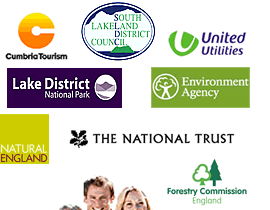Windermere South Basin and Windermere North Basin

Windermere is well-known as England's largest natural lake. It is often regarded as the most iconic lake in the Lake District it is well known and widely used, providing a focus at the heart of the area's resident and visitor communities. Locals and visitors alike enjoy the scenery, recreational opportunities, and wildlife it supports. The landscape of the Windermere catchment attracts in excess of 5 million visitors each year, providing the mainstay of the local economy. It is known that lakes bring economic value to communities thanks to tourism, the creation of new jobs, and environmental services. To study statistical data and economic indicators in numerical terms, it is necessary to form tables and charts, this can be done easily and quickly by sending a request do my excel homework for me to the https://specialessays.com/do-my-excel-homework/.
The lake has a public right of navigation enjoyed by yachts and motor cruisers. The shoreline is popular for smaller rowing boats and canoes and other general recreation. The lake is well-used for swimming, and hosts the Great North Swim event. There are 3 officially recognised Bathing Waters: at Fellfoot, Lakeside and Millerground, which are regularly monitored each summer for water quality.
The lake is also an important site for wildlife and nature conservation. It is home to the Arctic Charr - a cold water fish species surviving in the deeper cold waters, at the southern limit of its British range. The lake also supports brown trout, pike, perch, roach and eels, and salmon and sea trout pass through the lake to spawn in the tributaries.
The needs of the underwater and shoreline plant communities, fish and wintering wildfowl all need to be balanced with all the other demands. For example, old photos show how the reed-fringe around the edge of the lake has reduced and beds of water plants have been lost. For this reason the lake is the subject of a Management Strategy prepared by the LDNPA and SLDC, compiled in consultation with many other organisations who have an active interest in the lake. It was written in 2005, and now in 2010 is currently being reviewed to ensure its relevance for the next 5 years.
Scientifically, the lake is regarded as being 2 separate basins north and south, with different characteristics influenced by the geology hard volcanic rocks in the north basin, and softer shales in the south.
The lake has an important place in freshwater science, with a long history of monitoring by the Freshwater Biological Association (from 1945) and the Centre for Ecology and Hydrology (since 1989). The monitoring dates back to conditions prior to the lake receiving significant sewage inputs. Then there was a period of water quality decline linked to the installation of a sewerage network and waste-water treatment works (WwTW) that discharged into the lake. High levels of phosphate triggered algal blooms and associated summer de-oxygenation of the deeper waters, and toxic blue-green algae. Improvements at the WwTW included phosphate removal.
Windermere Profile
Catchment
Total area 230.5 km2
Geology Borrowdale Volcanics, to the north Silurian Slates, Grits and Flags to the south.
Land use Several settlements, farm land with deciduous and coniferous forest and fell beyond
Lake (north basin)
Maximum depth - 64 m
Mean depth - 25.1 m
Area - 8.05 km2
Volume - 201.8 m3 x 106
Retention Time - 6 months
Lake (south basin)
Maximum depth - 42 m
Mean depth - 16.7 m
Area - 6.72 km2
Volume - Unknown
Retention Time - 3 months
Current Water Quality Classification
Slightly eutrophic
Objectives
1. Reduce P to achieve a mean annual total phosphorus concentration < 10µg/L
2. Restore a more natural fish community
3. Identify opportunities to enhance the semi-natural vegetation of the lakeshores and aquatic macrophyte communities
4. Develop measures to prevent the introduction or the control of the spread of invasive species
5. Manage sedimentation to a more natural rate within the lake catchment
6. Ensure future water quality suitable for public benefit and enjoyment including meeting EU bathing standards at relevant sites
7. Promote sustainable management of land use and access for the local community and visitors
8. Determine future impacts of climate change and take measures to reduce/minimise these impacts as far as possible through sustainable land management practices
Key Actions
|
Lead Organisation (Other Orgs)
|
Restore more natural fish biomass and species composition appropriate action to be decided
|
CEH (FBA)
|
Draw up proposals to enhance the semi-natural vegetation of the lakeshores taking into account landscape, cultural heritage, agriculture and recreation, and implement agreed enhancement schemes
|
Windermere Reflections* (LDNPA, NE)
|
Establish measures to prevent establishment and/or spread of invasive non-native plant species
|
/
|
Complete appropriate catchment surveys to identify sediment sources and flows Complete an assessment of the rate of sedimentation in the lake Complete an evaluation of the impacts or benefits of the sedimentation Identify, where appropriate, remedial measures Implement remedial measures
|
Science Group
|
Identify and quantify any sedimentation processes affecting the lake and the implications of these for the long-term conservation of the lake
|
Science Group
|
Evaluate risk of climate change
|
WCRP
|
Upgrade sewage treatment works, pumping stations and combined sewer overflows
|
UU
|
Identify and address nutrient contribution from septic tanks and other non-main sewer sources including river systems
|
EA (NT, CT, SLDC, UU)
|
Initiate programme to reduce P inputs from community and tourism
|
CT (LDNPA, EA, SLDC, NT)
|
Establish project for restoration of lake shore vegetation including reed beds
|
FBA (LDNPA, NT, NE)
|
Control of non native geese (egg pricking etc.)
|
LDNPA (NT)
|
Establish sediment studies to investigate re-cycling of P from sediment
|
Science Group
|
Implement targeted Catchment Sensitive Farming programme in wider catchment
|
EA
|
Improve understanding of nutrient budgets within catchment
|
Science Group
|
Carry out measures to protect water quality from oil pollution and surface films
|
EA & SLDC
|
Glossary
CT - Cumbria Tourism
CEH - Centre for Ecology and Hydrology
EA - Environment Agency
FBA - Freshwater Biological Association
LDNPA - Lake District National Park Authority
NE - Natural England
NT - National Trust
SLDC - South Lakes District Council
UU - United Utilities
WCRP - Windermere Catchment Restoration Programme
|

